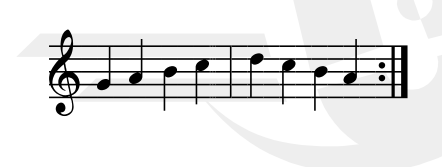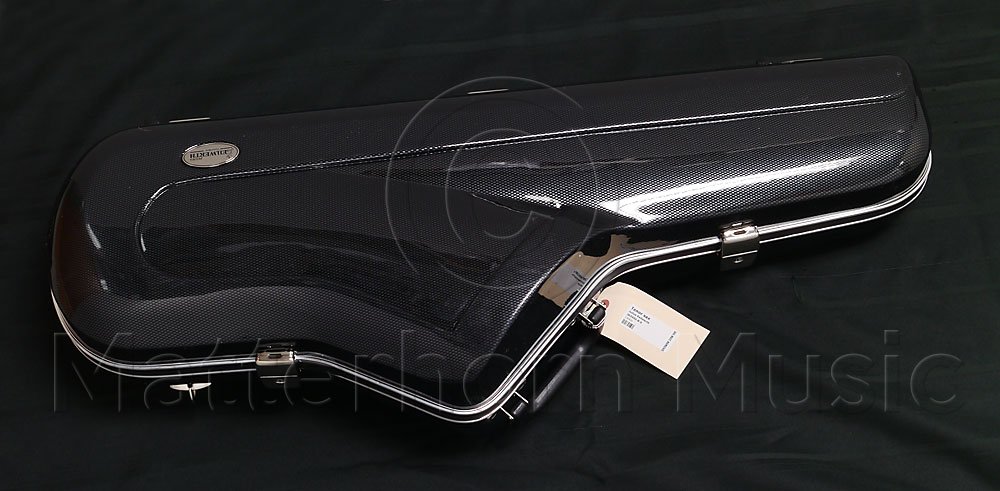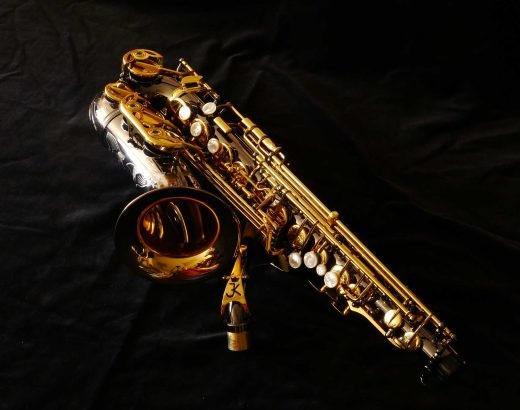
Keilwerth Tenor Sax SX90R: Model JK3400-8-0
Country of origin: Germany
Finish: Gold lacquer key and body finish
Price: varies greatly depending on where you live, and what currency you buy them in. This one is $9750 Cdn. at Matterhorn Music
Serial #: 130931
Date of manufacturing: circa 2021
Date of review: 2024
Set up used: Dukoff D5 refaced by Bob Carpenter to a 109 opening; Harry Hartman Copper Carbon Classic tenor saxophone 2.5 reed; and Rovner Light lig.
I have been meaning to write this review for over a year now. I have just had a lot of things happening that have prevented me from doing so. Then in May, my 1957 Toneking alto (laying down in photo on right) and my brand new Shadow tenor (middle horn in stands) went to the shop for David to do some minor adjustments. I figured this would be the perfect opportunity to get all the info I needed to get both the review of this tenor, as well as the SX90R alto, finalized.
I hope you find this as enjoyable and useful a read as it was for me to re-try both of these fantastic new horns by the Julius Keilwerth Company.
Availability
At the time of writing this horn is available for purchase through the Authorized Buffet/JK dealer, Matterhorn Music. Contact the shop and speak with David directly to find out more about this amazing horn.
Initial Thoughts – March 2023
I worked PT for David in a number of different rolls for about 4 years. During that time I had the opportunity to unpack, and be the first person to play this SX90R tenor when it first arrived at Matterhorn Music. These were my notes from that day:
When I first tried this horn, I didn’t have my regular MP with me, so I just grabbed a new Otto Link HR piece from the shop to try the horn with, and used a Harry Hartmann, MH Hemp Fiberreed M. I loved the SX90R from the first time I played it, and couldn’t wait to try it out with my own set up.
With the Link and Hartmann reed the SX90R simply vibrated under my fingers—much like my King Zephyr does. I said to David: If I was playing tenor all the time, I would seriously be thinking of ways to buy this horn.
Fast forward a couple of weeks, and I brought my regular Dukoff S7 and Légère 2 ¼ reed set-up, and I found the SX90R was a totally different animal. What a difference changes closer to the source of tone will make.
Tone
This Keilwerth SX90R tenor has a big, full, powerful tone, with tons of presence regardless of what range or dynamics your were playing. It subtoned beautifully, and had a screaming altissimo range that I’m sure hurt the ears of commercial tenants over the shop. 😉
Its core tone is beautiful, and with the right MP/reed/lig setup it would make a great horn for players looking for that tone and timbre. Me? Not so much, so my refaced Dukoff allowed this horn’s natural overtones to come out and fill the entire shop with the sound the JK is known for: complex, deep, and rich, yet also bright and extremely loud when played to its limits.
As my quoted comment from 2023 shows, the SX90R is extremely malleable. Depending on the set-up and attitude a player chooses/uses, various aspects of its complex tone can either be accentuated, or minimised, to get exactly the qualities a player is looking for.
Response
The SX90R tenor is a free blowing horn with very little resistance. In contrast, my 1957 Toneking tenor has more resistance, and is a bit harder to subtone on. That said, when played head to head the SX90Rs pedigree is obvious. The last 7 decades of saxophone development at Keilwerth have however, allowed the SX90R to be a more refined, and quicker responding horn than its predecessor. (It most definitely is not your grandfather’s Toneking. 😉 )
When compared to the SX90R Shadow I own though, the SX90R is not quite as quick to respond to changes in air flow. (More about that when I do the review on the Shadow.)
The SX90R tenor—like its smaller alto cousin—plays 100% evenly up and down the entire range of the horn. Again, this shouldn’t have to be stated, but far too many pro horns, or trying to pass themselves off as such, don’t have an even scale.
What I really love about playing the SX90R tenor is the ease with which the altissimo notes pop out. After being a Selmer playing for nearly 40 years, I gotta’ say, not having to fight to get my G3 to speak is a fantastic treat. The rest of the altissimo notes come out just as easily. All the tricks I used to have to employ to get F#4 and higher, no longer apply. The notes just come out in tune, consistently, each time.
Fun fact about this SX90R tenor that Matterhorn Music has in stock: it played straight out of the box. When it came in originally, I unpacked it and tried it. No problems. It subtoned down to low Bb immediately after shipping from Germany.
Feel
In a smiley/emoji:  Yup, I loved it.
Yup, I loved it.
The SX90R tenor is extremely well laid out ergonomically. It feels fantastic under your fingers. In many respects it is identical to my SX90R Shadow—which may be why I enjoy the horn as much as I do.
- The large, deep MOP key touches almost “grip” your fingers in the upper and lower stacks. These home keys—where you spend 75% + of your time as a player—are comfortable and were designed with player comfort and maximum ergonomic positioning in mind.
- The left palm keys are of course adjustable, making palm key risers a thing of the past.
- IMHO, the non-stick G# mechanism is the best thing that has been added to saxophones over the past 50 years. (Of course based on this design by Stathmann.) This allows you the freedom of playing the note without the worry of possible sticking. The feel it gives the G# is a sense of freedom. For me anyway.
Key Action
This horn is fast. David has made some minor adjustments on it since it came in to the shop, and it is certainly much faster than when I first tried it. Is it as fast as my Shadow? I’m not sure about that. It does feel to me like my Shadow does play a bit quicker, but maybe its my imagination?
To check the key action I did my usual 2 warmup exercises I do every time I play:
1. Going Over the Break
Here you tongue the G and slur to then end of phrase. Then tongue the first G again. You start out slowly, and keep going faster and faster, making sure your air is supported.
2. Pivot on the Break
Here again you start out slowly, and build up your speed until you are lightning quick.
On both these exercises the SX90R tenor was quick to respond; blew through the exercises with complete ease and zero resistance; and its evenness of scale was extremely evident.
Intonation
The SX90R tenor is 100% in tune across its entire range. Period. Full stop.
Keilwerth’s Description of their SX90R 3400 tenor sax
The SX90R Series saxophones offer a rich, solid tone that suits the player in any style of music from classical to jazz. Features include a wide bow and bell design allowing for a more responsive and fuller tone in lower registers, rolled tone holes to enhance projection and prolong pad life, adjustable palm keys to customize the key height and comfort to any player, and G# lever mechanism to prevent sticking keys. Different finish options are not only attractive but contribute toward the different tonal colors each variation provides.
Source: julius-keilwerth.com
Specs
According to the Keilwerth page, the following are the SX90R tenor’s specifications
Key |
Bb |
Range |
Low Bb to High F# |
Material |
German Brass |
Key buttons |
Mother of pearl |
Thumb Rest |
Metal, adjustable |
Pads |
Leather Pisoni |
Resonators |
Metal |
Engraving |
Laser precision engraved |
Tone holes |
Drawn with Hand Soldered Rings |
Key and body finish |
Gold lacquer |
Additional Features
- Post to body construction
- Slightly domed metal resos with rivet
Pics of the Keilwerth Tenor Sax SX90R: Model JK3400-8-0
Build
My usual disclaimer: I am not a tech, nor do I play one on TV. 
The Julius Keilwerth company has over 100 years of saxophone R&D and manufacturing experience to draw on, and it shows in every aspect of this saxophone.
The SX90R tenor is a fantastically solid, German engineered horn. It is obvious that JK’s 100 years of experience went into the design and build of this sax. It also very obvious that, if properly maintained, this horn will be around in a 100 years from today, since it is built like horns used to be: with care, precision, and high-quality materials meant to last a lifetime+.
My Toneking tenor from 1957 shares many of this SX90R’s same build qualities, and is proof that Keilwerth saxophones are built to last. Their new crop of pro horns is no different than their old ones in that regard.
Cons
The horn
You know, I was really trying to come up with at least 1 thing I didn’t really care for about the SX90R tenor. However, there was nothing about this horn from Keilwerth that I didn’t really, really like.
Furthermore, if you spend as much time in a shop seeing what’s coming in for repairs; playtesting other brands; and comparing the current crop of JK SX90R horns against what’s out there, you will likely come to the same conclusion that I have: The SX90R has nothing of substance in the negative column.
If I absolutely had to say something negative thing about the SX90R, it would be about the engraving. Don’t get me wrong, the laser engraving looks fantastic. But I have to wonder, why isn’t Keilwerth using craftspeople to hand engrave their horns anymore? Why is it only the Shadow (and maybe the black nickel plate?) that gets handcraftsmanship in that regard? I assume it has to do with cost? Anyway, to paraphrase Forrest Gump: That’s all I have to say about that. 😉
Accessories
The only real con that I find has nothing to do with the horn itself, but with the its primary accessory: Its case.
Ever since a foot on my B&S Medusa bari case broke off on the bottom of its Winter Shaped Baritone case, I have never been a huge fan of the brand. Truth be told, I also never really liked the way the Medusa slopped around while in its case.
Fast forward 2 decades, and uber-expensive Keilwerth pro models continue to come in none other than Winter cases that, you guessed it, have similar characteristics to my former bari case.
Although the style of case that the SX90R comes in has changed over the model’s production time, currently what is provided is described as follows on the Keilwerth website:
JK2195CA
Shaped case for Tenor saxophone. SX Line “carbon” finish:vacuum formed from ABS plastic in “carbon” look Aluminum valance for high stability
the polystyrene nest ensures excellent protection for the instrument and is lined with black premium cotton
velvet separate compartment for neck and mouthpiece
velvet accessory pocket to be put in the neck
2 nickel plated locks and 3 nickel plated metal hinges
4 bottom studs
backpack system and 2 backpack straps.
This is the case we’re talking about here, which looks like Winter’s Tenor Saxophone Shaped Case Thermoshock. I don’t know if JK orders the Polystyrene insert specifically shaped for their horns or not, but what arrives with the tenor is an epic fail.

The case is the same as the one that came with my SX90R Shadow. Within days of getting it home, I recorded the following video of the movement the horn has within the case. Not good.
This excess movement led to the thin polystyrene piece at the upper-most section of the case, giving way. The result? Way too much movement shown in above video, and greatly reduced protection for the uber-expensive Shadow.
I should note, by the time I recorded this, the horn hadn’t even gone to 1 rehearsal yet. It had only come home from the store I bought it at, and been put into a stand in my studio. I noticed this damage the first time I went to put it away to take it to a rehearsal.
Note: Keilwerth was fantastic about it and replaced the case under warranty. It did take months however before the dealer I bought it from got the new case—I opted for a totally different style case, but more on that when I write the review on the Shadow—which meant I had to use the ill-fitting broken case for about 4 months.
I checked the case that the SX90R tenor I play-tested at Matterhorn has. It is so far OK, but if it’s going to go, this is likely where it is going to happen.
Pros
Like with the SX90R alto, there are so many I can’t begin to list them all without sounding like I’m schilling for Keilwerth. Again, let me assure you: I am most definitely not doing that. (Remember I played Selmers and vintage American horns most of my musical career. Then I fell in love with some JKs I played, and the rest is as they say, history. 
So now that we have that out of the way, on to the list of pros:
- Extremely well built.
- Fantastic ergos.
- Left palm keys are a nicely adjustable.
- The non-stick G# key is a game changer.
- Action is light and fast.
- Intonation is spot on over the horn’s entire range.
- Goes from
 to
to  with no change in intonation or tonal distortion.
with no change in intonation or tonal distortion. - Has lots of overtones that can be brought out with the right MP.
- Has a lovely core tone that can easily be brought out with the right MP/reed set up.
- Just a dream to play compared to many comparably-priced pro horns on the market.
- Versatile enough that it can be used for virtually any style and genre of music.
Bottom Line
Over the last few years I have played new Selmers, Yanis, Yamahas, P. Mauriats, and many other lesser known, but not inexpensive Asian-made horns . Over that time I have come to the conclusion that it really is the wild west in the new saxophone marketplace, but in the end, you do get what you pay for. (Generally speaking.)
That is why for my $$, I ended up with a new SX90R Shadow, and why I play Keilwerths as my main alto, tenor, bari, and bass saxophones. (Still on the lookout for that perfect JK soprano to finish off the set. 
So to sum up: When you buy this SX90R tenor, you get a fantastic pro horn that will last you your lifetime—regardless of how old you are. Period. Full stop. That’s why I give this SX90R tenor a full 5/5 stars in its review.
Beware Though
As I wrote about in August 2021, fake Julius Keilwerth saxophones are found all over the Internet—and by extension, likely in some brick and mortar stores as well at times. That’s why it’s really important that when considering a new saxophone purchase, you buy through an authorized Buffet dealer. That is also the only way you are guaranteed to get the warranty these horns come with.
If you are buying used, make sure you know how to spot a fake JK. Also make sure that you buy through a reputable saxophone dealer like: PM Woodwind, Get A Sax, Worldwide Sax, etc. etc. These dealers are stand-up guys, know how to spot a fake, and stand behind the products they sell.































Always buy a SX-90 with a serial number ABOVE 110,000. The tone hole placement was altered at that point, resulting in near perfect intonation.
Yes, I had heard that there were some tone hole placement changes in the SX90 series. I wasn’t aware exactly when they were introduced. Thanks Steve!